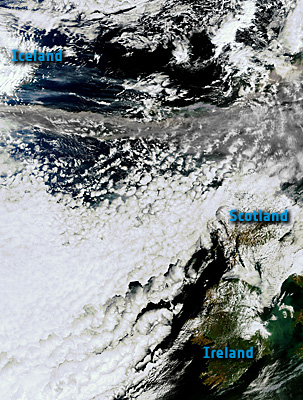On Thursday, the day the photo was taken, the ash spread towards Britain. It later caused the closure of airspace over large parts of Europe

The cloud, from the eruption of the volcano under the glacier Eyjafjallajoekull (Eyjafjallajoekull) in the southwest of Iceland, was carried high in the atmosphere. It meanwhile led to the closure of airports in Great Britain and Scandinavia, and later also to other areas in Northern Europe. The ash, which is seen as a gray mass over Europe drifts from west to east at a height of about 11 kilometers above the surface. It poses a serious danger to aircraft engines, and therefore caused the airspace to be closed. It should be noted that despite its proximity, the ash cloud was not visible from the ground and the sky above London was blue yesterday. The big concern is that flying inside the cloud, which contains dust and glass particles (from the melting of the ground in the great heat of the volcano) could wear out the engines of the planes.
The volcano erupted for the first time on March 20, after being quiet since 1821. On Wednesday, April 14, it erupted again. Due to the location of the volcano, under the glacier, the eruption caused water to melt and floods in its immediate vicinity.
The image was taken on Thursday, April 15, 2010 at 13:25 CET by the Medium Resolution Spectrometer (MERIS) of the Enbisat satellite.
Only a temporary respite in global warming
By the way, the ash balances for a short period and in the first stage the effects of global warming due to the fact that it returns the infrared radiation to space. After the eruption of the Pinatubo volcano in the Philippines in 1991, we also experienced a particularly cold and rainy winter in Israel, during which it even snowed. After that, the greenhouse gases emitted by the volcano will add to those emitted by humans and further increase the warming
More on the subject on the science website
- The sky in the Scream painting is red because of the eruption of a volcano half a world away from Europe
- Can we send robots to Earth's surface?
- A NASA satellite photographed the emission of smoke from the eruption of Mount Athena in Sicily on October 29, 2002 at an altitude of over one hundred kilometers
- When the earth attacks

14 תגובות
Noam, don't be evil, tell us...
Valuable prizes will be drawn among those who solve it correctly.
In any case, it must be remembered that this is only an approximation to the "thing in itself".
Hezi,
Sorry, I don't have a practical proof (what is it?), I just know it comes from the equations of general relativity.
To me it reminds me of that caterpillar from Alice in Wonderland who always smokes (there was something like that in Alice, right, I hope I'm not getting confused in another book/movie...)
pleasantness,
Based on what you say that?
I'm looking for practical proof, not theory...
Noam, what do you have in the picture? It gives me a strong association with Ren, but it can't be, can it?
It is the
A nagging question about gravitation (sorry it's not on the topic of the article):
Suppose a massive body collides with the Earth and deflects it from its orbit.
Will the moon be shifted immediately or only after the gravitational waves from the earth reach the moon?
In other words: is the speed of gravitational waves the same as the speed of light or higher than it?
Yaron, the problem is that the opening of the volcano is not very stable... a facility of enormous size must be built...
It is better to harness the power of the sun with the help of satellites...
If they find a way to use the greenhouse gases emitted from the volcano to create an alternative energy source, we will benefit twice. We will prevent global warming and pollute less - and of course whoever produces the energy will also benefit
The stoppage of flights also - causes to some extent the non-emission of greenhouse gases
I wonder if it is possible to do something to prevent contact between the lava and the water - for example, blow up parts of the glacier in advance, or drain the water that forms under it.